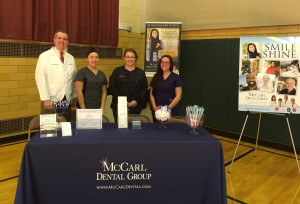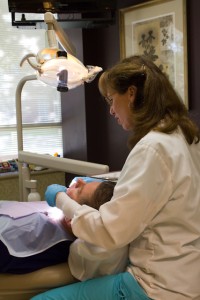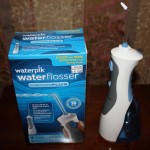Most adults have been brushing their teeth since they were toddlers, and many of them haven’t changed their brushing technique since then. A daily tooth brushing and flossing routine is the only way to ensure optimal oral health between dental checkups at McCarl Dental Group in Millersville, MD. Watch this informative video starring one of our knowledgeable dental hygienists, Sally Moore, who shares tips for effective tooth brushing, or keep reading to find out more.
(more…)
Tooth Brushing 101 from the McCarl Dental Group
December 21, 2015
All Your Flossing Questions Answered by Your Dentist in Greenbelt – McCarl Dental Group
December 2, 2015
Most patients are used to hearing questions about their flossing habits from the dentist. “How often do you floss?” “Do you floss between every tooth?” “Do you experience discomfort or bleeding during flossing?” Almost universally, our Greenbelt dental patients dread these questions. In a recent video, Dr. Jay McCarl takes the time to answer some of the most common flossing questions patients ask him. Watch this informative video from McCarl Dental Group or keep reading to find out more.
McCarl Dental Group Shared Oral Health Tips at the Annual Greenbelt Health & Wellness Fair
October 27, 2015
 McCarl Dental Group is fortunate to have an opportunity to take part in PG County community events that emphasize oral and overall health. The annual Greenbelt Health & Wellness Fair is one of our favorite events because we get to meet with members of the community and provide oral hygiene goodie bags, free dental consultations, and education on the best practices for at-home dental care. If you missed out on this year’s event, we hope to see you next year for this event dedicated to living happier, healthier lives, and we invite you to contact McCarl Dental Group to schedule a dental checkup and teeth cleaning.
McCarl Dental Group is fortunate to have an opportunity to take part in PG County community events that emphasize oral and overall health. The annual Greenbelt Health & Wellness Fair is one of our favorite events because we get to meet with members of the community and provide oral hygiene goodie bags, free dental consultations, and education on the best practices for at-home dental care. If you missed out on this year’s event, we hope to see you next year for this event dedicated to living happier, healthier lives, and we invite you to contact McCarl Dental Group to schedule a dental checkup and teeth cleaning.
(more…)
Dental Cleaning by Greenbelt Dental Hygienists
September 17, 2015
 Dental cleaning Greenbelt residents prefer isn’t just about having a beautiful smile it’s about optimal oral health, and you can’t get the same results from at-home care alone. Talk to our dentists or hygienists during your next visit about the powerful positive effects of consistent dental checkups and teeth cleanings. Our Millersville, MD dental team is determined to help patients achieve and maintain optimal oral health. Both our Greenbelt and Millersville, Maryland Dental Hygienists receive 5 star reviews! Call to schedule your six month checkup and hygiene appointment today. If you have periodontal disease, you may need to have your teeth cleaned professionally more frequently than every six months. Your dental hygienist and dentist will help you with a schedule that works best for you.
Dental cleaning Greenbelt residents prefer isn’t just about having a beautiful smile it’s about optimal oral health, and you can’t get the same results from at-home care alone. Talk to our dentists or hygienists during your next visit about the powerful positive effects of consistent dental checkups and teeth cleanings. Our Millersville, MD dental team is determined to help patients achieve and maintain optimal oral health. Both our Greenbelt and Millersville, Maryland Dental Hygienists receive 5 star reviews! Call to schedule your six month checkup and hygiene appointment today. If you have periodontal disease, you may need to have your teeth cleaned professionally more frequently than every six months. Your dental hygienist and dentist will help you with a schedule that works best for you.
(more…)
Common Causes of Missing Teeth
May 29, 2015

Our Greenbelt and Millersville Maryland Dentists help dental patients replace missing teeth and restore healthy functional smiles.
Have you seen Aziz Ansari’s question about missing teeth on your Chipotle bag? Chipotle decorates their bag with commentary from authors and comedians and calls it their “Cultivating Thought” series.
To answer Ansari’s question… Tooth loss is an indication of overall dental health and access to dental care.
Here are some common causes of tooth loss.
Untreated cavity – you wouldn’t believe how many people delay dental treatment or even ignore holes in their teeth! Unfortunately, a dental cavity cannot repair itself. If the area of tooth decay becomes too large it may be impossible to save the tooth. Regular dental check-ups are vital in identifying early tooth decay. Dental X-rays help us identify decay that may not be visible to the eye. Cleaning by a dental hygienist every six months or more frequently helps remove plaque and calculus and helps prevent cavities. And please don’t forget, prevention starts at home. Brush your teeth three times each day and floss your teeth daily.
Periodontal disease or gum disease is also a leading reason for tooth loss. Periodontal disease starts in the sulcus, the gap between the gum and the tooth. Gum diseases are usually divided into two categories, gingivitis and periodontitis.
Gingivitis is inflammation of the gums that causes tender, red, swollen gums that bleed easily. Gingivitis can progress to periodontitis which damages the bone and connective tissue that supports the teeth.
Symptoms of Periodontitis include:
• Gum inflammation, with redness and bleeding.
• Deep pockets or gaps that form between the gum and the tooth.
• And finally, loose teeth, caused by loss of connective tissue structures and bone.
Other risk factors for missing teeth include:
• Age – people older than 35 are at higher risk for loosing teeth
• Gender – men are at higher risk than women
• Lack of professional dental care
• Poor oral hygiene – not brushing teeth
• Smoking (current or past)
• Diabetes
• High blood pressure
• Rheumatoid arthritis
Our goal for our dental patients is that they keep healthy teeth for their lifetime. Our dentists and dental hygienists emphasize prevention and early treatment of tooth decay and periodontal disease. Our Greenbelt Dental Office is conveniently located near Riverdale Park 20737 , University Par 2782, College Heights Estates 20783 and College Park, 20740.
When tooth loss cannot be prevented, there are several options for tooth replacement. Dental implants are an excellent option for tooth replacement. Please read our blog about replacing missing teeth with dental implants.
Ansari continues his musing on the back of the bag about his quest for the perfect toothbrush. “Why do we always want the best?” he asks. Of course he goes to Google for the answer. How often do we do that?! Click below to hear our thoughts on the best toothbrushes.
Our Millersville Dental Office is located near Crownsville 21032, Gambrills 21054, Crofton 21114, Annapolis 21403, 21401 21409
Why Brush and Floss your Teeth?
January 22, 2013
Tooth brushing is one of the first lessons of personal care that we learn as children – for many of us, brushing our teeth is one of the first “health habits” that we are taught in life. Brushing and flossing your teeth is the simplest and most cost-effective way to preserve your oral health and to enjoy a lifetime of healthy teeth and gums.
McCarl Dental Group’s First Dental Visits for Pediatric Dental Patients are Fun and Free! Pediatric Dentistry is part of our comprehensive dental care at McCarl Dental Group. A child’s first dental visit should be scheduled around his or her 3rd birthday.
The most important part of the visit is getting to know and becoming comfortable with a dentist and dental hygienist. We entertain our pediatric patients with a ride up and down in the dental chair. Then we talk to them about opening wide so that we can shine a light into their mouth and count their teeth. Next the child tests the water by using the “Mr. Thirsty” suction and rinsing their mouth in the chairside basin. Finally we use our beloved puppet “Choppers” to teach tooth brushing technique.
A fun and comfortable first dental visit builds trust and helps put children at ease during future dental visits.
The American Dental Association (ADA) recommends that people brush their teeth twice every day – once at night before going to bed, and once in the morning. Brushing your teeth at night helps to remove bacteria and keeps your mouth clean while you sleep. Brushing your teeth in the morning helps freshen your breath and removes any bacteria that built up during the long night of sleep.
In addition to brushing your teeth twice a day, the ADA recommends that you floss once a day. Flossing is important because it allows you to clean in between your teeth – removing bacteria and plaque, and keeping your gums healthy. Flossing helps keep your gums in shape – if you don’t floss often enough, your gums might bleed, which, if you’re not careful, can be a sign of possible gum disease and infection.
Your oral health can be a reflection of your overall health. Sometimes the first sign of a disease shows up in your mouth. In other cases, infections in your mouth, known as periodontal disease, can cause problems in other areas of your body.
More than 75 percent of Americans over the age of 35 have some form of gum or periodontal disease. Signs of periodontal disease include: bleeding gums when brushing or flossing; red, swollen or tender gums; loose teeth; persistent bad breath; or receding gums. Sometimes there are NO obvious signs of periodontal disease. That is why routine professional dental exams are so important to your overall health.
Periodontal disease ranges from simple gum inflammation, called gingivitis, to a more serious disease, called periodontitis that causes gum tissue to pull away from the teeth forming pockets that become infected. Periodontitis results in damage to the bone supporting your teeth, and ultimately the loss of your teeth.
Periodontal disease is a chronic bacterial infection of the gums, and the byproducts of oral bacteria can enter the bloodstream. When oral bacteria escapes into the bloodstream it increases inflammation throughout the body and can injure major organs. Chronic inflammation is recognized as a significant factor in aging and disease.
Bacteria and inflammation from periodontal disease is associated with a number of serious health problems including:
• Heart disease
• Diabetes
• Dementia
• Rheumatoid arthritis
• Premature birth
Joint replacements: Gum disease is a major risk for infections in your joints after joint replacement surgery. Maintaining healthy gums and teeth is critical for preventing serious problems in your new joints. Current guidelines recommend taking antibiotics before having your teeth cleaned and any necessary dental work. Be sure to list joint replacements on your medical history at your dental office. Antibiotics are also recommended prior to dental care for patients who have had heart valve replacement.
If you have symptoms of periodontal disease, please take it seriously and call McCarl Dental Group in Millersville at 410-987-8800 or our Greenbelt Dental Office at 301-474-4144 for a thorough dental exam! You can also schedule an appointment online at https://www.mccarldental.com/locations.html
Is Smokeless Tobacco Harmful?
January 2, 2012
YES! Tobacco use remains the single largest preventable cause of disease and premature death in the United States.
At McCarl Dental Group we care about your oral health and also your overall health! We recently had a question regarding a YouTube video that one of our patients requested that we post on our website. Unfortunately, this patient was diagnosed with oral cancer. Fortunately his treatment was very successful. The cancer was located at the base of the tongue beyond visible range and was not visible upon oral examination. It was diagnosed by an ear nose and throat doctor. The question asked what percentage of people who dip everyday will get mouth cancer? We researched and were not able to find those specific statistics. Here is the information we found.
Wishing you a healthy and blessed New Year!
Harmful health effects of smokeless tobacco include:
- Mouth, tongue and throat cancer
- Cancer in the esophagus
- Stomach cancer
- Pancreatic cancer
- Increased risk of heart disease, heart attacks, and stroke
- Addiction to nicotine
- Leukoplakia (white sores in the mouth that can become cancer)
- Receding gums (gums slowly shrink from around the teeth)
- Bone loss around the roots of the teeth
- Abrasion (scratching and wearing down) of teeth
- Tooth loss
- Stained teeth
- Bad breath
Smokeless tobacco products are a major source of cancer-causing nitrosamines and a known cause of human cancer. They increase the risk of developing cancer of the mouth and throat, esophagus and pancreas. (Source: Cancer Prevention & Early Detection Facts and Figures 2010)
Smokeless tobacco products are considered less lethal but are NOT a safe alternative to smoking. Use of tobacco in any form harms health and can also lead to nicotine addiction.
Results from a large American Cancer Society study showed that people who switched from cigarettes to snuff or chewing tobacco had higher death rates from heart disease, stroke, cancer of the mouth and lung, and all causes of death combined than former smokers who stopped using ALL tobacco products.
The American Cancer Society, the World Health Organization, the National Cancer Institute and the U.S. National Toxicology Program have all issued strong reports warning on the adverse health effects of smokeless tobacco.
Lung cancer is the leading cause of cancer death in the United States for both men and women. (Source: Cancer Facts & Figures 2011)
Lung cancer is the most preventable form of cancer death in our society. (Source: Cancer Facts & Figures 2011)
Lung cancer estimates for 2011 (Source: Cancer Facts & Figures 2011):
New cases of lung cancer: 221,130
Males: 115,060
Females: 106,070
Deaths from lung cancer: 156,940
Males: 85,600
Females: 71,340
How often Should I have Dental Hygiene Appointments?
December 22, 2011

Greenbelt and Millersville Maryland Dental Hygienists at McCarl Dental Group
At McCarl Dental Group we recommend that all patients see one of our registered dental hygienists for routine prophylactic cleaning appointments at least every 6 months. For patients with gum disease we may recommend visits every 3-4 months. Our hygienists work with each one of our patients to ensure that they maintain optimum gum health, which means keeping their teeth healthier for years to come. With extensive training in the removal of tartar and plaque from the tooth surfaces and below the gums, dental hygienists play an active role in fighting periodontal disease.
Many people believe that if they do not have problems with their teeth, they do not need to have their teeth cleaned by a hygienist and examined by a dentist. This can mean a couple of years quickly turns into 5, 10, or even 15 before some people have another dental exam. Unfortunately, for most of these people, waiting longer between visits means unhealthy gums and sometimes very rampant tooth decay.
When plaque is missed from irregular flossing, it hardens and becomes tartar under the gumline. This contributes significantly to the destruction of gum and bone attachment levels around your teeth. Eventually this uncontrolled gum disease, correctly known as periodontal disease, can lead to tooth loss. Through routine cleaning appointments and screenings, patients can help prevent conditions including periodontal disease and advanced tooth decay.
The hygienists at McCarl Dental Group work with each individual patient to help them create an oral hygiene regimen that will work best for their own needs. Fifty percent of tooth and gum health comes from what you’re doing at home. Because every person’s mouth is different, so are his or her home care needs. What works for one person may not work for the next.
Hygienists don’t just clean teeth or check for suspicious areas of decay. They also screen for oral cancer and precancerous lesions of the mouth, head and neck. Many medical conditions and diseases of the human body first manifest themselves as symptoms that are seen in the mouth. Because people are more likely to see their hygienists for routine cleanings as opposed to annual physical exams with their doctor, many conditions are first found in the dental office. Many Dental Hygienists also offer nutritional counseling because of the vital connection between overall health and oral health.
McCarl Dental Group hygienists help promote and safeguard your overall health and wellness. If you’re behind on your dental hygienist visits, it’s better to be late than never. Contact us today to schedule your biannual cleaning appointment. You can reach our Millersville, Maryland dental office at (410) 987- 8800 or our Greenbelt, Maryland dental office at (310) 474-4144. You may also request an appointment online at www.McCarlDental.com.
What is Water Flossing?
December 2, 2011
Let’s face the facts. Like 99% of the American population, you probably don’t floss your teeth as often as you should. The majority of dental patients actually confess that they don’t even floss at all unless there is something stuck between their teeth.
How Often Should You Floss Your Teeth?
The American Dental Association recommends cleaning between teeth DAILY with dental floss or an interdental cleaner.
Why Should You Floss Your Teeth?
Unlike brushing, flossing reaches between teeth and helps treat and prevent conditions like tooth decay, gingivitis and periodontal disease, which can lead to tooth loss. Gingivitis is an early and reversible form of periodontal or gum disease.
Dentists, hygienists and product manufacturers have been trying to find a way to motivate patients to floss for years. The answer has finally come in a method that patients of McCarl Dental Group will both enjoy, comply with, and that is as effective as traditional flossing: the water flosser.
For years, products such as the Waterpik were recommended to patients with hard to reach areas around bridges, crowns, implants or braces. Recent studies show this method of plaque removal even more effective than flossing. (1) Many of our patients say that the water flosser is easier to use than dental floss.
The Waterpik Water Flosser is an oral irrigation device that delivers a steady stream of water and can flush out food particles, bacteria and plaque from under the gums and between teeth, where a toothbrush can’t reach.
For those who find flossing difficult, now a gentle stream of water can do the job. The added convenience of water flossers can also increase patient compliance in maintaining their oral hygiene. The result will be healthier gums, teeth and maintenance of oral appliances such as braces, bridges and implants.
You can purchase the Water Flosser at Bed Bath and Beyond and Target. Oral irrigation devices such as the Waterpik Water Flosser are available in various designs. The lower end models usually deliver one steady stream of water, while higher ends allow more customization in the pressure through manual controls. The water reservoir may be filled with a comfortable temperature of water to ensure patient comfort.
While it may take a little getting used to, many people prefer water flossers to traditional floss because of the convenience and ease of use. For patients with limited dexterity, flossing can be challenging. The Waterpik Water Flosser is easy to use. Dr. Clayton McCarl is currently using the Water Flosser for hard to reach areas before he flosses.
McCarl Dental Group wants to encourage and promote oral health for each of our patients. Part of that responsibility includes making you aware of successful products that can help achieve improved oral health. If you’re looking for a dentist, we would love to invite you to our office. Our Millersville dental office is conveniently located near Severna Park, Annapolis, Crofton, Crownsville, Gambrills, Glen Burnie and Severn, Maryland. Our Greenbelt Dental Office is close to College Park, Lanham, Seabrook, Bowie, New Carrollton, Laurel, Glen Dale, Bowie, Mitchellville, University Park and Hyattsville, Maryland . To schedule a preventative care appointment with us, call our Millersville, MD office at (410) 987-8800 or our Greenbelt dental office location at (310) 474-4144. You may also schedule a dental appointment with a dentist at McCarl Dental Group online at www.McCarlDental.com.
Reference:
1. Rosema NA, Hennequin-Hoenderdos NL, Berchier CE, Slot DE, Lyle DM, van der Weijden GA.; The effect of different interdental cleaning devices on gingival bleeding.;
J Int Acad Periodontol. 2011 Jan;13(1):2-10.
What is Dental Fluoride Varnish?
October 5, 2011
In the last few years, many new products have become important in dentistry. One of these products allowing advances in dental care is fluoride varnish. Fluoride varnish is quickly replacing dental fluoride foams and gels.
Advantages of Dental Fluoride Varnish
Varnish is extremely effective for the prevention of tooth decay.(i) Studies show that the varnish prolongs the contact time between fluoride and the tooth surface, which helps reduce the rate of tooth decay.(ii)
At McCarl Dental Group in Millersville, MD and Greenbelt, MD we provide fluoride varnish to pediatric patients up to the age of 14. We also perform this treatment on all patients who are undergoing orthodontic treatment. Patients with braces have an increased risk of decay, and fluoride varnish is shown to be extremely effective for this category of patients. For adult patients who have extreme sensitivity areas, or are prone to decay, this is an optional therapy they can request. Unfortunately, insurance companies typically only provide fluoride coverage to patients up to the age of 14, but many adult patients feel the small out of pocket cost is well worthwhile. For those adults who do not request fluoride varnish, our office offers a fluoride rinse or foam tray at no additional cost.
Fluoride varnish is simply applied to the tooth by using a small brush, similar to a paintbrush. This thick material is painted onto your tooth by dental hygienist, and the patient is advised to not brush their teeth for at least 6 hours. Unlike traditional fluoride treatments, there is no restriction on eating or drinking, so patients are able to leave the office and have a snack or meal immediately after their appointment. Following a fluoride varnish application, there may be a slight yellowish color and thin film on the tooth. This is the actual varnish clinging to your tooth, and it is only temporary.
For our patients who have a more sensitive gag reflex, varnishes are great, because there is no need to hold a large tray in the mouth. While traditional foam trays are worn for about a minute, varnish is applied even more quickly. It’s easier than brushing your teeth, because so little product needs to be applied.
To schedule a dental appointment, dental hygiene visit or dental exam call our Millersville Maryland dental office at 410-987-8800. Or, for a Dentist in Greenbelt Maryland, call 301-474-4144. You may also request a dental appointment online at www.mccarldental.com.
(i)Quock RL, Warren-Morris DP.: Fluoride varnish: the top choice for professionally applied fluoride.; J Mich Dent Assoc. 2011 May;93(5):42-8.
(ii) Lam A, Chu CH.: Caries management with fluoride varnish of children in U.S.; N Y State Dent J. 2011 Jun-Jul;77(4):38-42.

